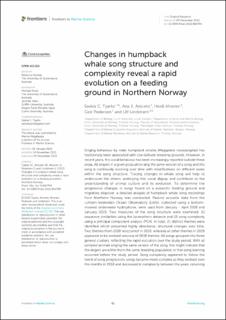| dc.contributor.author | Tyarks, Saskia C. | |
| dc.contributor.author | Aniceto, Ana Sofia | |
| dc.contributor.author | Ahonen, Heidi | |
| dc.contributor.author | Pedersen, Geir | |
| dc.contributor.author | Lindstrøm, Ulf Ove | |
| dc.date.accessioned | 2023-01-17T13:32:30Z | |
| dc.date.available | 2023-01-17T13:32:30Z | |
| dc.date.created | 2023-01-07T14:19:56Z | |
| dc.date.issued | 2022 | |
| dc.identifier.citation | Frontiers in Marine Science. 2022, 9 . | |
| dc.identifier.issn | 2296-7745 | |
| dc.identifier.uri | https://hdl.handle.net/11250/3044067 | |
| dc.description.abstract | Singing behaviour by male humpback whales (Megaptera novaeangliae) has traditionally been associated with low-latitude breeding grounds. However, in recent years, this vocal behaviour has been increasingly reported outside these areas. All singers in a given population sing the same version of a song and this song is continually evolving over time with modifications on different levels within the song structure. Tracing changes in whale song will help to undercover the drivers underlying this vocal display and contribute to the understanding of animal culture and its evolution. To determine the progressive changes in songs found on a subarctic feeding ground and migratory stopover, a detailed analysis of humpback whale song recordings from Northern Norway was conducted. Passive acoustic data from the Lofoten-Vesterålen Ocean Observatory (LoVe), collected using a bottom-moored underwater hydrophone, were used from January - April 2018 and January 2019. Two measures of the song structure were examined: (1) sequence similarities using the Levenshtein distance and (2) song complexity using a principal component analysis (PCA). In total, 21 distinct themes were identified which presented highly directional, structural changes over time. Two themes from 2018 reoccurred in 2019, whereas all other themes in 2019 appeared to be evolved versions of 2018 themes. All songs grouped into three general clusters, reflecting the rapid evolution over the study period. With all sampled animals singing the same version of the song, this might indicate that the singers are either from the same breeding population or that song learning occurred before the study period. Song complexity appeared to follow the trend of song progression; songs became more complex as they evolved over the months in 2018 and decreased in complexity between the years, returning to a more simplified song in 2019. The results confirm that humpback whale song exhibits a rapid progression on a shared subarctic feeding ground, with strong potential for song exchange and opportunities for cultural transmission between populations in the North Atlantic. | |
| dc.language.iso | eng | |
| dc.title | Changes in humpback whale song structure and complexity reveal a rapid evolution on a feeding ground in Northern Norway | |
| dc.title.alternative | Changes in humpback whale song structure and complexity reveal a rapid evolution on a feeding ground in Northern Norway | |
| dc.type | Peer reviewed | |
| dc.type | Journal article | |
| dc.description.version | publishedVersion | |
| dc.source.pagenumber | 17 | |
| dc.source.volume | 9 | |
| dc.source.journal | Frontiers in Marine Science | |
| dc.identifier.doi | 10.3389/fmars.2022.862794 | |
| dc.identifier.cristin | 2102475 | |
| dc.relation.project | Equinor: LoVe phase 1 | |
| dc.relation.project | Norges forskningsråd: 245843 | |
| cristin.ispublished | true | |
| cristin.fulltext | original | |
| cristin.qualitycode | 1 | |
